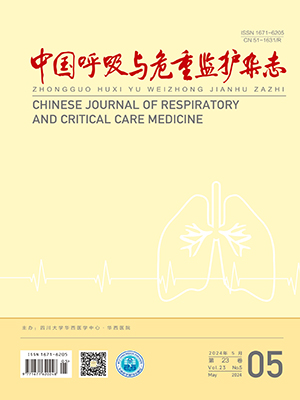| 1. |
Lin J, Wang W, Chen P, et al. Prevalence and risk factors of asthma in mainland China: The CARE study. Respir Med, 2018, 137: 48-54.
|
| 2. |
Hanania NA, Fortis S, Haselkorn T, et al. Omalizumab in Asthma with Fixed Airway Obstruction: Post Hoc Analysis of EXTRA. J Allergy Clin Immunol Pract, 2022, 10(1): 222-228.
|
| 3. |
Rutting S, Tonga K O, King G G. Toward explaining fixed airflow obstruction in asthma. J Allergy Clin Immunol, 2022, 149(3): 890-892.
|
| 4. |
李思念, 史菲. 固定气流受限性哮喘的研究进展. 内科, 2021, 16(1): 55-57.
|
| 5. |
Zhou A, Lei Y, Tang L, et al. Gut Microbiota: the Emerging Link to Lung Homeostasis and Disease. J Bacteriol, 2021, 203(4): 1-12.
|
| 6. |
Chiu C Y, Cheng M L, Chiang M H, et al. Gut microbial-derived butyrate is inversely associated with IgE responses to allergens in childhood asthma. Pediatr Allergy Immunol, 2019, 30(7): 689-697.
|
| 7. |
Wang Z, Lai Z, Zhang X, et al. Altered gut microbiome compositions are associated with the severity of asthma. J Thorac Dis, 2021, 13(7): 4322-4338.
|
| 8. |
中华医学会呼吸病学分会哮喘学组. 支气管哮喘防治指南(2020年版). 中华结核和呼吸杂志, 2020, 43(12): 1023-1048.
|
| 9. |
Bennett G H, Carpenter L, Hao W, et al. Risk factors and clinical outcomes associated with fixed airflow obstruction in older adults with asthma. Ann Allergy Asthma Immunol, 2018, 120(2): 164-168.
|
| 10. |
Graham B L, Steenbruggen I, Miller M R, et al. Standardization of Spirometry 2019 Update. An Official American Thoracic Society and European Respiratory Society Technical Statement. Am J Respir Crit Care Med, 2019, 200(8): e70-e88.
|
| 11. |
陈华萍, 王子, 李瑾, 等. 诱导痰细胞分类检查技术及应用. 中华肺部疾病杂志(电子版), 2020, 13(3): 399-402.
|
| 12. |
Buendia E, Zakzuk J, San-Juan-Vergara H, et al. Gut microbiota components are associated with fixed airway obstruction in asthmatic patients living in the tropics. Sci Rep, 2018(1), 8: 9582.
|
| 13. |
Mogensen I, Jacinto T, Alving K, et al. Inflammatory patterns in fixed airflow obstruction are dependent on the presence of asthma. PLoS One, 2020, 15(12): e243109.
|
| 14. |
Smith B M, Zhao N, Olivenstein R, et al. Asthma and fixed airflow obstruction: Long-term trajectories suggest distinct endotypes. Clin Exp Allergy, 2021, 51(1): 39-48.
|
| 15. |
Kim JH, Chang HS, Shin SW, et al. Lung Function Trajectory Types in Never-Smoking Adults With Asthma: Clinical Features and Inflammatory Patterns. Allergy Asthma Immunol Res, 2018, 10(6): 614-627.
|
| 16. |
Shimizu K, Tanabe N, Oguma A, et al. Parenchymal destruction in asthma: Fixed airflow obstruction and lung function trajectory. J Allergy Clin Immunol, 2022, 149(3): 934-942.
|
| 17. |
Lin W W, Karin M. A cytokine-mediated link between innate immunity, inflammation, and cancer. J Clin Invest, 2007, 117(5): 1175-1183.
|
| 18. |
Agrawal S, Agrawal A, Doughty B, et al. Cutting edge: different Toll-like receptor agonists instruct dendritic cells to induce distinct Th responses via differential modulation of extracellular signal-regulated kinase-mitogen-activated protein kinase and c-Fos. J Immunol, 2003, 171(10): 4984-4989.
|
| 19. |
Netea MG, Kullberg BJ, de Jong DJ, et al. NOD2 mediates anti-inflammatory signals induced by TLR2 ligands: implications for Crohn's disease. Eur J Immunol, 2004, 34(7): 2052-2059.
|
| 20. |
Vael C, Nelen V, Verhulst SL, et al. Early intestinal Bacteroides fragilis colonisation and development of asthma. BMC Pulm Med, 2008, 8: 19.
|
| 21. |
Rutting S, Thamrin C, Cross T J, et al. Fixed Airflow Obstruction in Asthma: A Problem of the Whole Lung Not of Just the Airways. Front Physiol, 2022, 13: 898208.
|
| 22. |
Duan H, Wang L, Huangfu M, et al. The impact of microbiota-derived short-chain fatty acids on macrophage activities in disease: Mechanisms and therapeutic potentials. Biomed Pharmacother, 2023, 165: 115276.
|
| 23. |
Wang Q, Li F, Liang B, et al. A metagenome-wide association study of gut microbiota in asthma in UK adults. BMC Microbiol, 2018, 18(1): 114.
|
| 24. |
Kieler IN, Shamzir KS, Vitger AD, et al. Gut microbiota composition may relate to weight loss rate in obese pet dogs. Vet Med Sci, 2017, 3(4): 252-262.
|
| 25. |
Theiler A, Barnthaler T, Platzer W, et al. Butyrate ameliorates allergic airway inflammation by limiting eosinophil trafficking and survival. J Allergy Clin Immunol, 2019, 144(3): 764-776.
|
| 26. |
Yip W, Hughes MR, Li Y, et al. Butyrate Shapes Immune Cell Fate and Function in Allergic Asthma. Front Immunol, 2021, 12: 628453.
|
| 27. |
Sohn KH, Baek MG, Choi SM, et al. Alteration of Lung and Gut Microbiota in IL-13-Transgenic Mice Simulating Chronic Asthma. J Microbiol Biotechnol, 2020, 30(12): 1819-1826.
|




